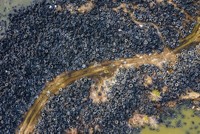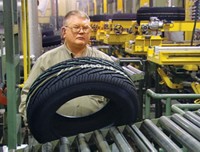Advertisement
Grab your lab coat. Let's get started
Welcome!
Welcome!
Create an account below to get 6 C&EN articles per month, receive newsletters and more - all free.
It seems this is your first time logging in online. Please enter the following information to continue.
As an ACS member you automatically get access to this site. All we need is few more details to create your reading experience.
Not you? Sign in with a different account.
Not you? Sign in with a different account.
ERROR 1
ERROR 1
ERROR 2
ERROR 2
ERROR 2
ERROR 2
ERROR 2
Password and Confirm password must match.
If you have an ACS member number, please enter it here so we can link this account to your membership. (optional)
ERROR 2
ACS values your privacy. By submitting your information, you are gaining access to C&EN and subscribing to our weekly newsletter. We use the information you provide to make your reading experience better, and we will never sell your data to third party members.


At Goodyear Tire & Rubber’s proving grounds in San Angelo, Texas, sports cars snake through cones on wet pavement, dump trucks rumble down dirt roads, and semitrailers coast down long tracks. Each year, the company puts about 20,000 tires through these tests to evaluate their traction, toughness, and fuel efficiency.
Vitals
Current affiliation: Goodyear Tire & Rubber
Age: 35
PhD alma mater: University at Buffalo
Hometown: Lyndonville, New York
If I were an element, I’d be: “Carbon. It is a key component in a variety of organic compounds that make up living organisms, oils, polymers, etc. And it can take on many different amorphous and crystalline forms, such as carbon black, carbon nanotubes, graphite, graphene, diamonds, and other advanced materials that all play so many important roles in our lives today.”
My favorite TV show is: “Breaking Bad. I thought Bryan Cranston and all of the actors did such a good job with the story and the characters. I also appreciated Walter White’s knowledge of chemistry and his attention to detail and quality.”
Goodyear principal scientist Rob Dennis- Pelcher’s job is to identify a mix of tire materials that optimizes all these properties while decreasing the tire’s negative effects on the environment. It’s a difficult task. A modern tire might contain 20 components, including natural and synthetic polymers to form rubber, reinforcing fillers to increase strength, and additives to improve performance. “It’s really a balance of a lot of different factors,” says Dennis-Pelcher, who specializes in reinforcing filler materials like silica and carbon black.
Right now, many tire components are derived from petroleum, but Goodyear aims to produce a tire using all biobased, recycled, or otherwise sustainable materials by 2030. Dennis-Pelcher was part of a team that last year unveiled a demonstration tire made with 90% sustainable materials. The tire included carbon black derived from soybean oil and silica made from rice husks, among other materials. But tackling the other 10% of the tire’s ingredients—and ensuring a commercial version isn’t too expensive—will require an enormous amount of creativity.
“We use so much of these materials,” Dennis-Pelcher says. “Even if you develop a solution, getting it to scale and getting it to work across the board in all the applications we need can be quite complicated.”
Dennis-Pelcher scouts out ways to achieve these sustainability goals by talking with existing suppliers, identifying new collaborators with promising technologies, and scouring peer-reviewed papers and patents. In most cases, he can’t simply drop new materials into Goodyear’s manufacturing process. So he works with outside companies to refine their technologies and ensure their products won’t interfere with other tire chemicals.
In 2022, Dennis-Pelcher started working with Austin, Texas–based company Molecular Rebar Design (MRD) on a US Department of Energy–funded project to improve tire lifespan and energy efficiency using the firm’s dispersed carbon nanotubes. These nanotubes provide more reinforcement than conventional fillers like carbon black and silica, according to August Krupp, director of MRD’s rubber business. He says this feature will allow tire companies to use less filler material and make a more energy-efficient tire while improving structural integrity. Although MRD developed the carbon nanotube fillers, Dennis-Pelcher has published six patents proposing methods to improve the materials and incorporate them into tires. “It’s not just us innovating. He has to innovate too,” Krupp says.
Advertisement
Some of Dennis-Pelcher’s innovations are already on the road. Last year, Goodyear started selling tires that contain a more sustainable carbon black made by the firm Monolith. Conventional carbon black is produced by burning petroleum or coal tar, but Monolith uses renewable electricity to pyrolyze methane into hydrogen and carbon, avoiding carbon dioxide generated by combustion.
Ned Hardman, Monolith’s vice president and R&D fellow, says Monolith’s product contains less sulfur than conventional carbon black. Sulfur is a key element used to vulcanize, or harden, rubbers, and it can significantly affect tire chemistry. Hardman credits Dennis-Pelcher with tweaking Goodyear’s manufacturing process to account for the lower sulfur content, a task that required modifying several components at the same time. “Vulcanization science is beautiful chemistry, but it’s amazingly complex,” Hardman says. “That requires incredibly deep thinking.”
The tire industry still has a long way to go to achieve its sustainability goals. Goodyear, Michelin, and other tire makers have struggled to develop an inexpensive, biobased version of isoprene, a polymer used to make synthetic rubber. And the tiny particles tires fling into the air as they wear down remain a persistent source of pollution.
Overcoming those hurdles will require a variety of new technologies, so Dennis-Pelcher is constantly hunting for ideas with a glimmer of potential. Often, peer-reviewed papers or new patents don’t lay out a complete map to industrialization, so he must fill in the gaps by combining different chemistries and technologies. “That sparks my interest,” he says.
Consumer Products
Rob Dennis-Pelcher
This materials scientist scouts out technologies to improve tire performance and sustainability
by Matt Blois
May 17, 2024
| A version of this story appeared in
Volume 102, Issue 15

Credit: Jessica Yanesh/Goodyear Tire & Rubber/C&EN
Vitals
Current affiliation: Goodyear Tire & Rubber
Age: 35
PhD alma mater: University at Buffalo
Hometown: Lyndonville, New York
If I were an element, I’d be: “Carbon. It is a key component in a variety of organic compounds that make up living organisms, oils, polymers, etc. And it can take on many different amorphous and crystalline forms, such as carbon black, carbon nanotubes, graphite, graphene, diamonds, and other advanced materials that all play so many important roles in our lives today.”
My favorite TV show is: “Breaking Bad. I thought Bryan Cranston and all of the actors did such a good job with the story and the characters. I also appreciated Walter White’s knowledge of chemistry and his attention to detail and quality.”
At Goodyear Tire & Rubber’s proving grounds in San Angelo, Texas, sports cars snake through cones on wet pavement, dump trucks rumble down dirt roads, and semitrailers coast down long tracks. Each year, the company puts about 20,000 tires through these tests to evaluate their traction, toughness, and fuel efficiency.
Goodyear principal scientist Rob Dennis- Pelcher’s job is to identify a mix of tire materials that optimizes all these properties while decreasing the tire’s negative effects on the environment. It’s a difficult task. A modern tire might contain 20 components, including natural and synthetic polymers to form rubber, reinforcing fillers to increase strength, and additives to improve performance. “It’s really a balance of a lot of different factors,” says Dennis-Pelcher, who specializes in reinforcing filler materials like silica and carbon black.
Right now, many tire components are derived from petroleum, but Goodyear aims to produce a tire using all biobased, recycled, or otherwise sustainable materials by 2030. Dennis-Pelcher was part of a team that last year unveiled a demonstration tire made with 90% sustainable materials. The tire included carbon black derived from soybean oil and silica made from rice husks, among other materials. But tackling the other 10% of the tire’s ingredients—and ensuring a commercial version isn’t too expensive—will require an enormous amount of creativity.
“We use so much of these materials,” Dennis-Pelcher says. “Even if you develop a solution, getting it to scale and getting it to work across the board in all the applications we need can be quite complicated.”
Dennis-Pelcher scouts out ways to achieve these sustainability goals by talking with existing suppliers, identifying new collaborators with promising technologies, and scouring peer-reviewed papers and patents. In most cases, he can’t simply drop new materials into Goodyear’s manufacturing process. So he works with outside companies to refine their technologies and ensure their products won’t interfere with other tire chemicals.
In 2022, Dennis-Pelcher started working with Austin, Texas–based company Molecular Rebar Design (MRD) on a US Department of Energy–funded project to improve tire lifespan and energy efficiency using the firm’s dispersed carbon nanotubes. These nanotubes provide more reinforcement than conventional fillers like carbon black and silica, according to August Krupp, director of MRD’s rubber business. He says this feature will allow tire companies to use less filler material and make a more energy-efficient tire while improving structural integrity. Although MRD developed the carbon nanotube fillers, Dennis-Pelcher has published six patents proposing methods to improve the materials and incorporate them into tires. “It’s not just us innovating. He has to innovate too,” Krupp says.
Some of Dennis-Pelcher’s innovations are already on the road. Last year, Goodyear started selling tires that contain a more sustainable carbon black made by the firm Monolith. Conventional carbon black is produced by burning petroleum or coal tar, but Monolith uses renewable electricity to pyrolyze methane into hydrogen and carbon, avoiding carbon dioxide generated by combustion.
Ned Hardman, Monolith’s vice president and R&D fellow, says Monolith’s product contains less sulfur than conventional carbon black. Sulfur is a key element used to vulcanize, or harden, rubbers, and it can significantly affect tire chemistry. Hardman credits Dennis-Pelcher with tweaking Goodyear’s manufacturing process to account for the lower sulfur content, a task that required modifying several components at the same time. “Vulcanization science is beautiful chemistry, but it’s amazingly complex,” Hardman says. “That requires incredibly deep thinking.”
The tire industry still has a long way to go to achieve its sustainability goals. Goodyear, Michelin, and other tire makers have struggled to develop an inexpensive, biobased version of isoprene, a polymer used to make synthetic rubber. And the tiny particles tires fling into the air as they wear down remain a persistent source of pollution.
Overcoming those hurdles will require a variety of new technologies, so Dennis-Pelcher is constantly hunting for ideas with a glimmer of potential. Often, peer-reviewed papers or new patents don’t lay out a complete map to industrialization, so he must fill in the gaps by combining different chemistries and technologies. “That sparks my interest,” he says.







Join the conversation
Contact the reporter
Submit a Letter to the Editor for publication
Engage with us on Twitter